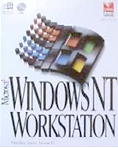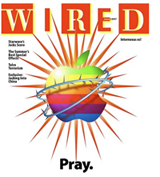25 Unanswerable Questions About Apple
Apple's history has had more moments of truth than that of any other tech company. Maybe any other company, period. Discuss.By Harry McCracken | Wednesday, November 26, 2008 at 1:10 pm
12. What if Sony had bought Apple?
![]() Sun and Oracle made real attempts to buy Apple, but another much-discussed scenario (mentioned in Jim Carlton’s book Apple among other places) involved Sony doing the acquiring. I don’t know if anyone at Sony gave even a millisecond of actual thought to the idea, but the logic would have been obvious. Especially since Sony was thriving at the time and hadn’t yet rolled out its VAIO desktops and laptops.
Sun and Oracle made real attempts to buy Apple, but another much-discussed scenario (mentioned in Jim Carlton’s book Apple among other places) involved Sony doing the acquiring. I don’t know if anyone at Sony gave even a millisecond of actual thought to the idea, but the logic would have been obvious. Especially since Sony was thriving at the time and hadn’t yet rolled out its VAIO desktops and laptops.
Harry’s guess: Sony Macs would have been beautiful from an industrial design standpoint. And, over time, undistinguished-to-horrific when it came to software. They might have ended up as good-lookin’ machines running stock Microsoft Windows–in other words, exactly like the VAIOs that Sony ended up making. As for the iPod? Sony probably wouldn’t even have considered releasing an Apple-designed or -branded music player–hey, it was the company that invented the Walkman.
13. What if the next-generation Mac OS had been built on top of Windows NT?
 In 1996, Gil Amelio became CEO of Apple and inherited (and killed) Copland, an ambitious, ill-fated attempt to build a next-generation Mac OS. Not unreasonably, he came to the conclusion that Apple would need to buy rather than build the platform for Apple’s next OS. Among the scenarios he seriously considered was licensing Microsoft’s Windows NT and adding a Apple-esque layer on top of it.
In 1996, Gil Amelio became CEO of Apple and inherited (and killed) Copland, an ambitious, ill-fated attempt to build a next-generation Mac OS. Not unreasonably, he came to the conclusion that Apple would need to buy rather than build the platform for Apple’s next OS. Among the scenarios he seriously considered was licensing Microsoft’s Windows NT and adding a Apple-esque layer on top of it.
Harry’s guess: There’s such a rich history of Apple-Microsoft squabbling that it’s tough to mentally process the notion that the Mac OS might have ended up being Windows. If it had, it would have been hobbled by at least some of Windows’ security and reliability woes. More important, a deal with Microsoft would have meant that Amelio wouldn’t have bought Steve Jobs’ NeXT, thereby setting off the events that led to Jobs’ return from exile and Amelio’s ouster. Anyone out there want to make the case that Apple would have come up with the iMac, iPod, iTunes, Apple TV, and iPhone if Amelio had run it for another decade?
14. What if Apple had bought Be instead of NeXT?
 Former Apple executive Jean-Louis Gassée’s BeOS was a basically admirable to build a modern, multimedia-centric operating system from scratch. And Amelio came close to acquiring it for use as the basis of an all-new Mac OS in 1996 before striking a deal with Steve Jobs for NeXT instead.
Former Apple executive Jean-Louis Gassée’s BeOS was a basically admirable to build a modern, multimedia-centric operating system from scratch. And Amelio came close to acquiring it for use as the basis of an all-new Mac OS in 1996 before striking a deal with Steve Jobs for NeXT instead.
Harry’s guess: A Be-based Mac OS might have been quite good–or at least a whole lot better than the creaky OS 9 it would have replaced. But Gassée was among the execs whose decisions left Apple in its battered condition of the mid 1990s. There’s virtually no chance that The Return of Jean-Louis would have been anything like The Return of Steve.
15 What if Apple had simply ceased to exist circa 1997?
 “What would I do? I’d shut it down and give the money back to the shareholders.” That was Dell Computer founder Michael Dell’s proposal for ending Apple’s mid-1990s agony, and it didn’t sound like crazy talk at the time. We’ll never know how close Apple came to death in the months before Steve Jobs’ return turned it around. But the company was running out of cash–and running out of products that anyone other than Mac diehards wanted to buy. At the very least, death seemed like a more likely scenario at the time than a return to vibrant good health.
“What would I do? I’d shut it down and give the money back to the shareholders.” That was Dell Computer founder Michael Dell’s proposal for ending Apple’s mid-1990s agony, and it didn’t sound like crazy talk at the time. We’ll never know how close Apple came to death in the months before Steve Jobs’ return turned it around. But the company was running out of cash–and running out of products that anyone other than Mac diehards wanted to buy. At the very least, death seemed like a more likely scenario at the time than a return to vibrant good health.
Harry’s guess: If Apple had croaked in 1997, PCs, the Web, and consumer electronics would still have headed into their most innovative era ever. But the company’s influence has been so profound in the Jobs II era that it’s certain that the industry would have been quite different without it, and probably poorer. Who knows? We might all have ended up downloading music from a Tower Records service onto our Diamond Rio MP3 players and being entertained by Red Hat’s “I’m a Linux Computer” TV commercials. Or, alternatively, destined to slip ever deeper into a mire in which Microsoft monopolized just about everything.
16. What if Steve Jobs had never come back?
 The $429 million that Apple paid for NeXT in December, 1996 bought it an impressive operating system that had failed to find much of a market. It also bought it an advisor named Steve Jobs. Who soon became an interim CEO named Steve Jobs. And then a CEO named Steve Jobs, which he remains to this day. Jobs also continued to run Pixar until its sale to Disney, but it’s safe to say at this point that Apple is the man’s life work.
The $429 million that Apple paid for NeXT in December, 1996 bought it an impressive operating system that had failed to find much of a market. It also bought it an advisor named Steve Jobs. Who soon became an interim CEO named Steve Jobs. And then a CEO named Steve Jobs, which he remains to this day. Jobs also continued to run Pixar until its sale to Disney, but it’s safe to say at this point that Apple is the man’s life work.
Harry’s guess: This is a toughie. I think you’d still be able to buy a computer with an Apple logo on it in 2008 even if Jobs had never returned…but it’s most likely that it would be a pretty prosaic computer, and it might be manufactured by some other large company and might run Windows. (Think of Gateway, which is now simply a nameplate slapped onto Acer boxes.) As for Steve Jobs, who knows? It’s less than likely that he would have been able to transform NeXT on its own into a digital entertainment powerhouse, or the world’s most interesting phone company. He might have focused all his energies on Pixar. Or started one or more additional innovative and successful companies. (Me, I’m glad he ended up back where he started.)
«PREVIOUS PAGE 1 2 3 4 5 NEXT PAGE»
16 Comments
Read more:
14 Comments For This Post
2 Trackbacks For This Post
-
MarshalSandler.com » MyAppleSpace - A little space for the rest of us Says:
November 27th, 2008 at 4:56 am[…] 25 Unanswerable Questions About Apple […]
-
Matas blog » Blog Archive » Truputis tikrai gerų straipsnių Says:
December 7th, 2008 at 7:59 am[…] 25 neatsakomi klausimai apie Apple […]













November 26th, 2008 at 3:01 pm
Hey, cool! You gave us a bonus question: the second question 5. 🙂
November 26th, 2008 at 3:10 pm
I messed up the numbering…fixed!
–Harry
November 26th, 2008 at 4:15 pm
Great piece, Harry. Enjoyed it a lot!
Thanks,
Marcin
November 27th, 2008 at 3:33 am
The fact is, if Steve jobs had been easier to deal with (he threw a pile of contract prepared by IBM, saying he wants a one page contract and that is all) today all PCs would be running mac os.(remember this is long before windows and at the time it is so ahead of it’s time)
November 27th, 2008 at 4:44 pm
Louis: You’re thinking of something that happened at NeXT. IBM wanted to license the NeXT OS for the IBM PC as an alternative to WIndows, not MacOS (although maybe you’re sort making the case that NeXT Step is the same as MacOS X).
Here’s some what ifs:
– What if Apple had decided to focus its engineering efforts on improvements to the Apple II and build a GUI on top of the Apple II rather than create the Apple ///, Lisa, and Mac?
– What if the Apple /// had a fan (and didn’t have the overheating problem which lead to its failure)?
– What if Apple had allowed the spin-off of Newton, Inc. to occur?
– What if Claris had been allowed to run as a separate independent software company?
– What if Metrowerks hadn’t existed and the transition to PowerPC had been fumbled due to lack of native applications?
November 27th, 2008 at 11:17 pm
To the list, I would add the following (arguably answerable) question:
Q: What if Steve Jobs had been willing to wait just one more year for the Motorola 68010 chip to become available for mass production?
A: The Mac could have debuted with hardware support (allowing OS support) for virtual and protected memory in 1985! Instead, the Macintosh System Software was compromised at its very foundations from the start with a shared-memory scheme that allowed apps to crash the OS (also a weak point of pre-NT Windows), and which remained a legacy weakness of the “classic” Mac OS all the way up through Mac OS 9.
November 28th, 2008 at 1:07 pm
great article thanks…its made me think..:-)
November 29th, 2008 at 4:30 pm
Harry, this was as well-thought-out and reasoned as any retrospective-slash-look-forward as I’ve read.
Excellent, balanced, and “sluethful,” if you will.
Congrats.
December 1st, 2008 at 2:57 pm
You guys are definitely true nerds.
December 3rd, 2008 at 12:59 am
What if Apple bought Sun today?
…
@Brant: Apple did build a GUI onto an improved Apple ][ compatible – the 16-bit IIGS, which came out after the first Macs.
Nevertheless you pose a very interesting question. If resources of the /// and Lisa projects had gone into building the Mac system software on improved ][-compatible hardware, they could conceivably have ended up with a cheaper box, backwards hardware- and software- compatibility, and a much easier transition for the thousands of homes, businesses – and significantly, schools – with existing investment in the ][ series architecture.
At the time, they were the number one personal computer brand, and first year Mac sales were disappointing. If they had managed to keep and build on the lead they had developed with the ][s, well …
December 3rd, 2008 at 2:35 pm
@drbunsen
Don’t forget that sales of Apple IIs funded ALL of Apple’s development on the Apple ///, the Lisa, and the Macintosh through at least the end of the 80’s.
Additionally there was always resentment within Apple between the teams: Non-Aple II teams resented that the Apple II was still the more popular computer and cash cow of the company; the Apple II team resented that not only were the other teams getting all the attention, but that the Apple II was first relegated to schools and home use only (at the introduction of the Apple ///) and then it was supposed to fade away entirely after the introduction of the Mac. In the meantime the Apple II kept many business, scientific, and other professional users happy and productive (see Visicalc, the first “killer app,” and later AppleWorks).
In hindsight, the two things I think Apple should have done differently about the Apple II vs. other Apple computers conflict are:
1) Adopted the third-party Apple II tricks by companies like Applied Engineering that allowed 80-columns, lowercase, expanded memory, etc. and incorporated them into the Apple /// so that it was more fully software/hardware compatible with existing Apple II software. At its release the Apple ///’s emulation of the Apple II was considered intentionally crippled. The truth is that it emulated a stock Apple ][+ just fine, but almost no one was running only a stock Apple ][+. The upgrades they’d made to their Apple ][+s weren’t compatible with the Apple ///, though, so the software they had that required the upgrades wouldn’t work.
2) Used better IC sockets on the Apple /// motherboard, or no sockets at all. The cheap sockets they initially used are what caused its reliability problems and doomed the machine. Alternately a fan would have also worked, but given Steve Jobs’ penchant for fan-less computers better sockets would have been the only realistic solution.
Given the two of the above, one more step would have ensured futher success: Not forcing their products lines into distinct “home and school” and “business” niches. People turned away when they tried to buy an Apple II for their business and were told that it wasn’t a suitable machine and they were steered towards the Apple /// for $1000 more. Thankfully Apple will now cheerfully sell businesses iMacs and Mac Minis and MacBooks even though they aren’t “Pro” machines.
The user interface of the Lisa was actually initially developed on Apple IIs and ///s, with prototype mice. Years later there were many GUI apps that ran on the Apple IIe (before the IIgs) like MouseWrite, MouseDesk (a Finder-like program), MouseCalc, StyleWrite, and GraphicWriter (desktop publishing, on an 8-bit Apple II!). That’s proof that the hardware was up to the task. If the Apple /// had been a success, AND a true successor to the Apple II, it would have been a unified platform that the Lisa/Mac GUI software could have been released on. It already had a fairly robust O/S, with a hierarchical filing system, hard drive support, standardized device drivers, expanded memory support up to at least 256K, etc. It took a LOT of additional work for the Mac to get these things after its initial release.
FWIW, Apple also worked on a 68000 co-processor card, which could have allowed for a graceful transition from 8-bit processors to 16-bit, with full backwards-compatibility (much like their later 680×0 to PowerPC to Intel transitions, which learned lessons from the poor Apple II to post-Apple II transition).
December 12th, 2008 at 9:21 pm
2. You have a strange definition of “borrowed”: “Xerox was given Apple stock in exchange for engineer visits and an understanding that Apple would create a GUI product” [Wikipedia, Xerox PARC] It’s even arguable that Xerox earned more from the Apple stock than they ever did from the Alto or the Lisa-priced Star hardware despite PARC’s unquestionable innovations. See “Fumbling the Future: How Xerox Invented, Then Ignored, the First Personal Computer”, Smith and Alexander, 1988.
Furthermore, to judge by the recollections of the team members of the Lisa and Macintosh, available at folklore.org, their GUI development was well along before Jobs ever visited PARC. It certainly was different: The Alto, like early DOS GUIs and the original Windows, didn’t have overlapping windows, while the Lisa OS did. And LisaGraf/QuickDraw, the assembler-based graphics routines (which could be considered a simpler precursor to PostScript) were Bill Atkinson’s baby, all right.
6. Steve Jobs didn’t found Pixar, he bought it from George Lucas (and quite the investment it turns out to have been).
…Not sure if I want to read the rest, just pulling this together took much longer than reading the first page (no single-page version?) and I don’t want to lose more time reading it.
December 22nd, 2008 at 11:25 am
A smaller but still-interesting question:
What if Apple had stuck with PowerPC instead of migrating to Intel?
December 16th, 2009 at 11:39 am
‘Let alone’, dammit, not let along. Does that make sense? Did someone disable spell-check?